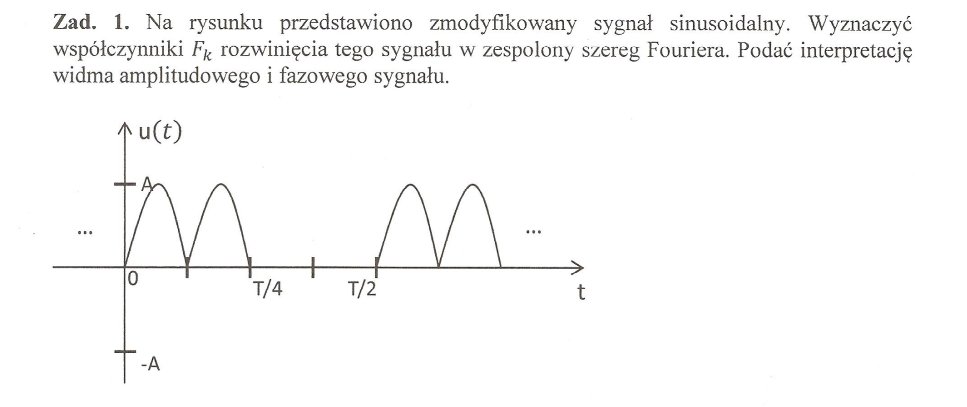This is too long for a comment. I also needed the extra space. Feel free to comment anything.
The thing you are really asking is if the calculation is made with T/8 or T/4 or T/2. The thing is, the signal has a period of T/2, so that's the value you need to use. Now, we also need to take into account the time interval where the signal is 0. To do that, we need to define the signal properly.
The first thing you should do is to describe the signal, that is:
$$
f(t)=\left\{\begin{array}{ccc}\Biggl|A\sin\Bigl(2\pi\frac{4}{T}t\Bigr)\Biggr|&&t\in\biggl(0+k\frac{T}{2},\frac{T}{4}+k\frac{T}{2}\biggr),\,k\in\mathbf{Z}\\0&&t\in\biggl(\frac{T}{4}+k\frac{T}{2},\frac{T}{2}+k\frac{T}{2}\biggr),\,k\in\mathbf{Z}
\end{array}\right.$$
Note the sinusoid has amplitude A and period T/4, but the second semi-period is positive (so we use the absolute value).
The expression for f(t) is the same as:
$$
f(t)=\left\{\begin{array}{ccc}A\sin\Bigl(2\pi\frac{4}{T}t\Bigr)&&t\in\biggl(0+k\frac{T}{2},\frac{T}{8}+k\frac{T}{2}\biggr),\,k\in\mathbf{Z}\\-A\sin\Bigl(2\pi\frac{4}{T}t\Bigr)&&t\in\biggl(\frac{T}{8}+k\frac{T}{2},\frac{T}{4}+k\frac{T}{2}\biggr),\,k\in\mathbf{Z}\\0&&t\in\biggl(\frac{T}{4}+k\frac{T}{2},\frac{T}{2}+k\frac{T}{2}\biggr),\,k\in\mathbf{Z}
\end{array}\right.$$
Remember that
$$c_n=\frac{1}{P}\int_{t_0}^{P+t_0}f(t)e^{-2\pi j \frac{n}{P}t}\,dt$$
In our case, P is the period (P=T/2), j is the imaginary unit, and t_0 is the initial instant (say t_0=0). Then,
$$\begin{array}{rcl}
c_n=\frac{2}{T}\int_{0}^{\frac{T}{2}}f(t)e^{-2\pi j \frac{2n}{T}t}\,dt&=&I_1+I_2+I_3
\end{array}$$
where I'll only calculate I_1 to get the idea going:
$$\begin{array}{rcl}
I_1&=&\frac{2}{T}\int_0^{\frac{T}{8}}A\sin\Bigl(\frac{8\pi}{T}t\Bigr)e^{-2\pi j\frac{2n}{T}t}\,dt\\
&=&\frac{2A}{T}\int_0^{\frac{T}{8}}\frac{e^{j\frac{8\pi}{T}t}-e^{-j\frac{8\pi}{T}t}}{2j}\cdot e^{- j\frac{4\pi n}{T}t}\,dt\\
&=&\frac{A}{jT}\int_0^{\frac{T}{8}}e^{j\frac{8\pi}{T}t}e^{-j\frac{4\pi n}{T}t}\,dt-\frac{A}{2j}\int_0^{\frac{T}{8}}e^{-j\frac{8\pi}{T}t}e^{-j\frac{4\pi n}{T}t}\,dt\\
&=&\frac{A}{jT}\Biggl( \frac{T}{8\pi-4\pi n}e^{j2\pi\frac{2-n}{T}t}\Biggr|_{0}^{\frac{T}{8}}-\frac{T}{-8\pi-4\pi n}e^{-j2\pi\frac{2+n}{T}t}\Biggr|_{0}^{\frac{T}{8}}\Biggr)\\
&=&\frac{A}{jT}\Biggl( \frac{T}{8\pi-4\pi n}(e^{j2\pi\frac{2-n}{T}\frac{T}{8}}-1)+\frac{T}{8\pi+4\pi n}(e^{-j2\pi\frac{2+n}{T}\frac{T}{8}}-1)\Biggr)\\
&=&\frac{A}{j}\Biggl( \frac{1}{8\pi-4\pi n}(e^{j\pi\frac{2-n}{4}}-1)+\frac{1}{8\pi+4\pi n}(e^{-j\pi\frac{2+n}{4}}-1)\Biggr)\\
&&\\
I_2&=&\frac{2}{T}\int_{\frac{T}{8}}^{\frac{T}{4}}-A\sin\Bigl(\frac{8\pi}{T}t\Bigr)e^{-j\frac{4\pi n}{T}t}\,dt\\
&=&...\\
&&\\
I_3&=&\frac{2}{T}\int_{\frac{T}{4}}^{\frac{T}{2}}0e^{2\pi j\frac{2n}{T}t}\,dt\\
&=&0
\end{array}$$
I believe this is all you need to get your calculations correct now... Good luck!

